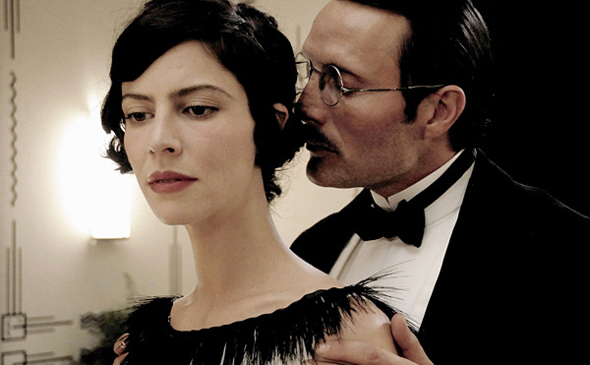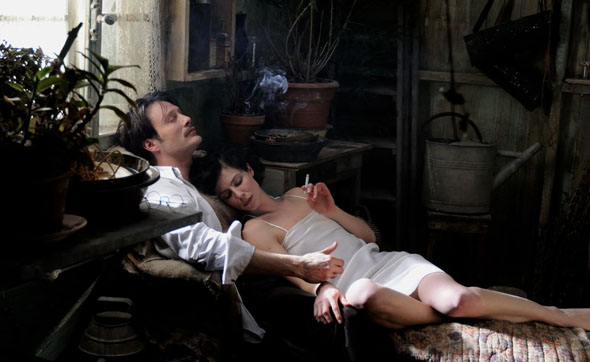 Picking up where Anne Fontaine’s Coco Before Chanel left off, Jan Kounen’s Coco Chanel & Igor Stravinsky provides a dual portrait of two icons of the 1920s, who had a brief, passionate romance that coincided with highpoints of their respective careers.
Picking up where Anne Fontaine’s Coco Before Chanel left off, Jan Kounen’s Coco Chanel & Igor Stravinsky provides a dual portrait of two icons of the 1920s, who had a brief, passionate romance that coincided with highpoints of their respective careers.
The film opens with a scene depicting the scandalous 1913 Paris premiere of Stravinsky’s legendary ballet “The Rites of Spring”, with its commissioner Sergei Diaghilev (Grigori Manukov) seen pacing nervously. Fearful of rejection, Igor Stravinsky (Mads Mikkelsen) remains backstage, being comforted by his wife and musical adviser, Catherine (Elena Morozova). The scene uses rhythmic editing to create excitement and drama, cutting between the orchestra, dancers and the audience. As the music becomes increasingly confronting, the audience becomes increasingly aggravated by the crashing, percussive score. Dismissed by many at the time as barbarous trash, it was later recognized as a defining moment in the split between romantic and modern music, and serves as a unique moment for the paths of these two figures to cross, as Chanel (Anna Mouglalis) witnesses the event admiringly from her seat.
The film then rushes through World War I to cut to 1920 Paris, post-Russian Revolution where Diaghilev first introduces Igor to Coco. Stravinsky is still struggling, impoverished and exiled, to make a living while Chanel is the head of her own successful fashion house. She invites him and his family to move into her villa outside Paris where he can work on his music, hardly masking her affections and ulterior motive.
Shortly after the family moves in, Coco offers herself to Igor, and the affair commences under the knowing nose of Catherine, who continues to correct her husband’s increasing passionate compositions in a pained silence. Rather than depict the affair as lovingly romantic, the graphic sex scenes portray more primal animalistic urges, as the two creative forces thrive off each other and their professional lives reap the fruits of their passions. During this time, Stravinsky composes his “Symphonies for Wind Instruments” and “Five Easy Pieces” and Chanel develops her infamous No. 5 perfume. However, egos ad Igor’s suffering family ultimately intrude.
 The film, written by Chris Greenhalgh and based on his own novel, feels somewhat limited in that there is very little background and context given, and the dialogue remains at surface level. What this creates is the experience of what it may have been like to be in the same rooms as these personalities, but it is difficult to invest fully in the emotions of what’s happening, as it’s difficult to get a sense of the motivations that drove these people (beyond their sexual endeavors).
The film, written by Chris Greenhalgh and based on his own novel, feels somewhat limited in that there is very little background and context given, and the dialogue remains at surface level. What this creates is the experience of what it may have been like to be in the same rooms as these personalities, but it is difficult to invest fully in the emotions of what’s happening, as it’s difficult to get a sense of the motivations that drove these people (beyond their sexual endeavors).
Mouglalis captures the elegant look and composure of Chanel, but her cool steeliness makes her somewhat inaccessible to watch at times. The opposite is true for Mikkelsen, who is perhaps too physically commanding compared to the actual Stravinsky, but captures the composer’s spirit and artistic temperament in a way that is intriguing to watch.
The production design on this film is fantastic, as set designer Marie-Helene Sulmoni has done an exquisite job. With locations including the Theatre des Champs-Elysees where “The Rites of Spring” caused its uproar, Chanel’s chic villa, and the lab in Grasse where Chanel No. 5 was created, there is much pleasing eye candy.
This film has a sophisticated feel, and a few great moments, but ultimately its emotionally distant pair may have a difficult time connecting to audiences. In the end, it’s an interesting moment in history that could have been developed so much more to be an enriching story. I enjoyed watching in, but left slightly disappointed, thinking about what it could have been.

